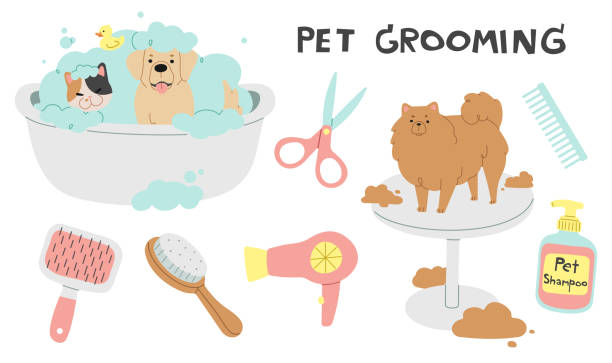
Groom Like a Pro: How to Train Your Pet to Love Grooming Tools and Stay Calm
Learn expert-approved techniques to help your pet overcome fear of grooming tools, build trust, and enjoy grooming sessions—making nail trims, brushing, and baths stress-free for both you and your furry friend.
🐶 Pet Star
31 min read · 3, Jul 2025

Understanding the Importance of Grooming Training
Why Comfort with Grooming Tools Matters
Regular grooming is essential for your pet’s health and happiness. Brushing prevents matting, nail trimming avoids painful overgrowth, and cleaning keeps infections at bay. Yet, many pets fear grooming tools—brushes, clippers, nail files—which can make grooming stressful for both pet and owner.
Training your pet to be comfortable with these tools is more than convenience—it promotes wellbeing. Stress during grooming can cause behavioral issues, injury risks, and missed care. A calm pet enjoys better hygiene and a stronger bond with you.
The Psychology Behind Grooming Anxiety
Pets often associate grooming tools with discomfort, noise, or restraint. Dogs and cats have sensitive senses; the sound of clippers or the sensation of a brush might be startling or painful if used improperly.
Understanding this helps you approach training with patience and empathy. Conditioning your pet to positive associations with grooming tools rewires their response, reducing fear and resistance.
Preparing for Grooming Training: Setting the Stage for Success
Gathering the Right Tools
Before starting, assemble all necessary grooming tools: brushes, combs, nail clippers, grooming scissors, and even electric clippers if needed. Choose quality, pet-friendly tools designed to minimize discomfort. For example, rounded-tip scissors prevent accidental cuts, and quiet clippers reduce noise anxiety.
Creating a Calm Environment
Select a quiet, comfortable space with good lighting. Avoid distractions and ensure the pet feels safe—use their favorite blanket or bed. Soft background music or pheromone diffusers can further relax anxious pets.
Understanding Your Pet’s Body Language
Learning to read signs of stress—such as lip licking, yawning, avoidance, or stiff posture—helps you gauge comfort levels and know when to pause or adjust your approach.
Step-by-Step Training to Introduce Grooming Tools
Introducing Tools Gradually
Start by simply showing your pet the tools. Let them sniff and explore at their own pace. Offer treats and praise for calm behavior. Avoid forcing interaction—this builds trust and curiosity.
Desensitization to Sounds and Movements
Many pets fear the noise of clippers or the sensation of brushes. Record the sounds and play them at low volume during playtime, gradually increasing volume while offering treats. Mimic grooming motions without touching your pet, allowing them to get used to the experience.
Touch Conditioning
Gently touch your pet’s paws, ears, and coat without tools, rewarding calmness. Slowly introduce the brush or clipper by resting it lightly against the fur, paired with positive reinforcement.
Short, Positive Sessions
Keep initial training sessions brief—just a few minutes—to prevent overwhelm. Gradually extend time as your pet becomes more comfortable.
Techniques for Specific Grooming Tools
Brushing and Combing
Use Appropriate Brushes: Different coats need different brushes—slicker brushes for mats, bristle brushes for short hair. Using the right tool prevents discomfort.
Slow, Gentle Strokes: Brush in the direction of hair growth with light pressure. Pause to reward calmness and avoid pulling on tangles; use detangling sprays if necessary.
Positive Reinforcement: Pair brushing with treats or play. For cats, incorporate grooming into daily cuddle sessions to normalize it.
Nail Trimming
Start with Paw Handling: Regularly handle paws without trimming to build tolerance.
Use Proper Clippers: Guillotine-style or scissor-style clippers designed for pets reduce risk.
Trim Gradually: Only clip small amounts, especially for beginners. Learn to avoid the quick, the sensitive blood vessel in nails.
Reward Generously: Praise and treats after each nail build positive associations.
Bathing and Drying
Use Lukewarm Water: Water that is too hot or cold can distress your pet.
Use Pet-Safe Shampoos: Human shampoos can irritate skin; opt for gentle, veterinary-approved products.
Desensitize to Spraying: Spray water slowly and softly, starting away from the face.
Drying Tips: Use towels first; if using dryers, start with low noise and airflow settings, pairing with treats.
Addressing Common Challenges
Dealing with Fear and Aggression
If your pet shows aggression, don’t punish; instead, slow training pace and consider professional help. Fear-based aggression often stems from anxiety and can worsen if forced.
Handling Squirmy or Restless Pets
Distraction techniques like toys, treats, or calming pheromones can help. Frequent short breaks prevent frustration.
Overcoming Resistance to Nail Trims
If trimming is especially difficult, try filing nails gradually over several sessions or use vet visits for stressful steps initially.
Tools and Technologies to Ease Grooming
Quiet Electric Clippers
Many brands now offer noise-reduced clippers designed for nervous pets.
Self-Cleaning Brushes
Simplify grooming by reducing hair buildup, making sessions quicker.
Grooming Gloves
These combine brushing and massage, easing sensitive pets into the grooming process.
Wearable Calming Devices
Collars or diffusers that release calming pheromones can help pets stay relaxed.
The Role of Routine and Consistency
Building a Grooming Schedule
Regular grooming—weekly brushing, monthly nail checks—helps pets know what to expect, reducing anxiety over time.
Involving Family Members
Familiar people handling grooming helps generalize comfort across situations.
Expert Advice and Insights
Veterinarian Perspective
Dr. Lisa Hernandez emphasizes, “Early exposure to grooming tools is key. Begin when pets are young, but it’s never too late to start. Patience and positive reinforcement build lifelong comfort.”
Professional Groomer Tips
Groomer Amanda Blake suggests, “Break grooming into manageable steps. Reward frequently and stop before your pet gets tired or stressed. Consistency beats intensity.”
Behavioral Conditioning: Using Positive Reinforcement Effectively
Why Positive Reinforcement Works
Positive reinforcement is the cornerstone of training pets to be comfortable with grooming tools. Unlike punishment, which can increase fear or aggression, rewarding desired behavior strengthens the association between grooming and positive experiences.
Scientific studies confirm that pets trained with rewards such as treats, praise, or play exhibit reduced stress and faster learning. For example, a 2018 study in Applied Animal Behaviour Science found dogs trained with treats during grooming showed 40% less stress-related behavior than those trained without rewards.
Choosing the Right Rewards
Effective rewards vary per pet:
- Food treats: Soft, small, and highly palatable treats work best during grooming.
- Verbal praise: Enthusiastic words and petting can motivate many dogs and cats.
- Play breaks: Incorporate favorite toys or short play sessions as a reward.
- Environmental enrichment: Letting your pet explore or sniff in a safe area after grooming is another effective motivator.
Timing and Consistency
Timing rewards immediately after the desired behavior reinforces learning. In grooming, praise your pet the moment they tolerate the tool or remain calm during a touch.
Consistency across sessions and handlers ensures the pet reliably associates grooming tools with positive outcomes, building lasting comfort.
Tailoring Training to Different Pets
Training Dogs
Dogs often respond well to routine and rewards. Early socialization with grooming tools, ideally between 8 to 16 weeks of age, can reduce anxiety later. Larger breeds may require more desensitization due to the volume of fur and intensity of grooming.
Breed-specific considerations:
- Long-haired breeds like Afghan Hounds need daily brushing, requiring early acceptance.
- Short-haired breeds may resist brushing but still benefit from nail and ear care.
Training Cats
Cats’ independent nature means training should be slow and gentle. Many cats dislike restraint, so letting them explore tools freely without pressure is vital. Using grooming gloves or brushes that mimic petting can help ease cats into grooming.
Studies show that cats trained with a calm environment and positive reinforcement tolerate grooming better, with fewer scratches or bites.
Small Animals and Exotic Pets
Rabbits, guinea pigs, and ferrets also require grooming but can be more sensitive. Use soft brushes and handle gently. Nail trimming often needs to be done by professionals if the pet is nervous.
Health Benefits of Proper Grooming
Preventing Skin Issues
Regular grooming removes dead hair, distributes oils, and stimulates circulation. This helps prevent common skin problems like hot spots, dandruff, and infections.
According to the American Veterinary Medical Association, neglected grooming can lead to matted fur, which traps moisture and bacteria, causing painful skin conditions.
Early Detection of Health Problems
Training pets to tolerate grooming tools allows owners to regularly inspect for lumps, ticks, or wounds—crucial for early diagnosis.
Veterinary experts recommend monthly grooming as part of routine health checks.
Grooming During Different Life Stages
Puppies and Kittens
Early exposure to grooming tools shapes lifelong tolerance. Use soft brushes and short sessions. Reward heavily to create a positive first experience.
Adult Pets
For adult pets fearful of grooming, gradual desensitization is key. Avoid overwhelming them; break grooming into short, manageable steps over weeks or months.
Senior Pets
Older pets may have sensitive skin or arthritis. Choose gentle grooming tools and prioritize comfort over speed. Consult your vet for special care recommendations.
Conclusion
Training your pet to be comfortable with grooming tools is a transformative process that benefits both the animal and the owner. It requires patience, consistency, and a deep understanding of your pet’s unique personality and needs. By gradually introducing grooming tools through positive reinforcement and desensitization, you create a trusting environment that reduces fear and stress, turning grooming sessions from a chore into an opportunity for bonding.
The health benefits of regular grooming are profound—preventing skin infections, detecting health issues early, and promoting overall wellness. Importantly, a well-trained pet who accepts grooming tools is safer to care for and less likely to develop behavior problems related to fear or discomfort.
Modern tools and technology can support this training journey, making the experience smoother and more enjoyable. However, remember that every pet is different, and some may require professional help or customized approaches, especially those with past trauma or special needs.
Ultimately, the goal is to establish a grooming routine that respects your pet’s boundaries while encouraging cooperation. The more positive experiences your pet has, the more comfortable they will become, leading to stress-free grooming for years to come. By investing the time and care to train your pet properly, you are fostering a healthier, happier relationship that extends well beyond the grooming table.
Q&A Section
Q1: What is the best way to introduce grooming tools to a fearful pet?
A: Start slowly by letting your pet explore the tools without pressure. Use treats and praise to create positive associations and gradually increase exposure over multiple sessions.
Q2: How often should I groom my pet at home?
A: Frequency depends on your pet’s breed and coat type. Generally, brushing once or twice a week and nail trims every 3-4 weeks are good guidelines.
Q3: Can grooming reduce behavioral problems in pets?
A: Yes, regular grooming helps pets feel comfortable in their bodies, reduces anxiety, and can decrease aggressive or fearful behaviors related to discomfort.
Q4: What if my pet refuses to let me trim their nails?
A: Try desensitizing by handling paws regularly without trimming. Use treats and patience. If needed, consult a vet or professional groomer for assistance.
Q5: Are electric clippers safe for pets?
A: Yes, if used correctly. Choose quiet, pet-specific clippers and introduce them gradually to avoid startling your pet.
Q6: How can I tell if my pet is stressed during grooming?
A: Look for signs like lip licking, yawning, panting, avoidance, or stiff body posture. If these occur, pause and offer comfort.
Q7: Is it better to groom my pet myself or go to a professional?
A: Both have benefits. At-home grooming fosters bonding and routine care, while professionals handle complex tasks and anxious pets safely.
Q8: What grooming tools are best for sensitive skin?
A: Use soft-bristle brushes, grooming gloves, and gentle shampoos formulated for sensitive skin to minimize irritation.
Q9: Can I train an older pet to accept grooming tools?
A: Absolutely. Older pets may need slower, gentler training, but with patience and positive reinforcement, many learn to tolerate grooming.
Q10: How do pheromone diffusers help during grooming?
A: They release calming scents that reduce anxiety, helping pets relax during grooming sessions.
Similar Articles
Find more relatable content in similar Articles

Pets and Mental Health: The Science Behind Emotional H..
Discover the profound impact o.. Read More

The Growing Trend of Therapy and Emotional Support Ani..
Exploring the remarkable rise .. Read More

How Climate Change Affects Wild and Domestic Animals...
Climate change is dramatically.. Read More

How Pets Strengthen Family Bonds...
Pets are more than just compan.. Read More
Explore Other Categories
© 2024 Copyrights by rPets. All Rights Reserved.